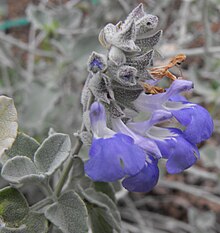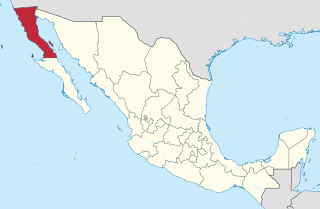
Salvia columbariae is an annual plant that is commonly called chia, chia sage, golden chia, or desert chia, because its seeds are used in the same way as those of Salvia hispanica (chia). It grows in California, Nevada, Utah, Arizona, New Mexico, Sonora, and Baja California, and was an important food for Native Americans. Some native names include pashí from Tongva and it'epeš from Ventureño.

Salvia pratensis is a species of flowering plant in the family Lamiaceae, native to Europe, western Asia and northern Africa. The specific epithet pratensis refers to its tendency to grow in meadows. It also grows in scrub edges and woodland borders.
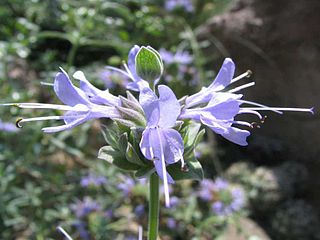
Salvia clevelandii, the fragrant sage, blue sage, Jim sage and Cleveland sage, is a perennial plant that is native to Southern California and northern Baja California, growing below 900 m (3,000 ft) elevation in California coastal sage and chaparral habitat. The plant was named in 1874 by Asa Gray, honoring plant collector Daniel Cleveland.

Salvia candelabrum is a species of flowering plant in the family Lamiaceae, native to Spain. It is a woody-based perennial growing to 100 cm (39 in), with woolly grey-green leaves that resemble those of the common sage, S. officinalis, and emit a similar scent when crushed. In summer it bears violet-blue flowers on branching stems held high above the foliage.
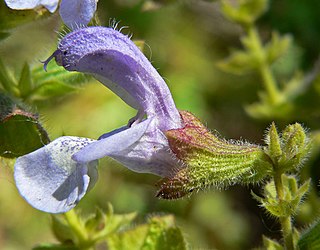
Salvia africana is a heavy branched aromatic perennial shrub native to the coast of the Cape Provinces of South Africa, found on coastal dunes and in nearby rocky hills up to 600 m elevation. It grows to 60–90 cm, with round grayish stems covered with hairs that release a strong scent when brushed. The leaves are a soft grey-green, lighter on the underside, and elliptical shaped. The inflorescences reach 30 cm long, with 2-6 flowers in each whorl, ranging from pale blue to pale violet or pink.
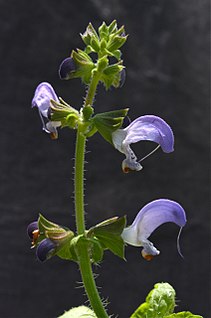
Salvia algeriensis is an annual Salvia native to northeast Morocco and northwest Algeria, found growing at up to 600 m (2,000 ft) elevation. In its native habitat, it grows nearly 1 m (3.3 ft) in height, with bright green ovate leaves about 8 cm (3.1 in) long and wide. Each plant produces 3-4 inflorescences up to 15 cm (5.9 in) long, with light violet flowers that have violet specks on the lower lip. The plant has a light scent when crushed, similar to thyme.
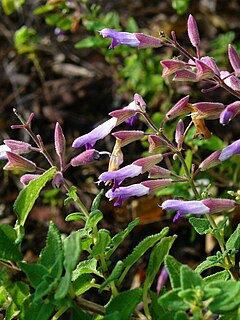
Salvia semiatrata is a perennial native to the Sierra Madre del Sur in the Mexican state of Oaxaca, growing at elevations of 6,500 ft (2,000 m) or higher. It prefers the edges of pine forests, and is also found on limestone cliffs and banks and in cactus scrub habitats that are dry and exposed.
Salvia taraxacifolia is a herbaceous perennial shrub that is native only to southwest Morocco, growing in the Atlas Mountains at elevations ranging from 2,000 feet (610 m) to 8,000 feet (2,400 m). Very adaptable, it grows on limestone slopes, forest clearings, and rocky riversides. It has no close allies in the genus Salvia. The specific epithet, taraxacifolia, is likely Persian in origin and means 'leaves shaped like a dandelion'.

Salvia transsylvanica is a herbaceous perennial native to a wide area from north and central Russia to Romania. It was described and named in 1853 by botanist Philipp Johann Ferdinand Schur, with the specific epithet referring to the Transylvanian Alps located in central Romania. It was introduced into horticulture in the 1980s.
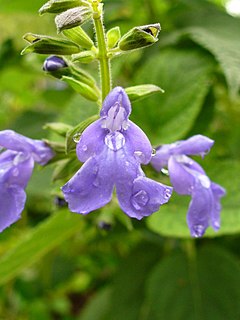
Salvia urica is a herbaceous perennial native to the mountains of Guatemala, Honduras, Belize, and Chiapas, Mexico. It is reportedly most common in Guatemala, where it grows in a wide variety of habitats from 1,000 to 8,000 feet elevation, in a mild and moist climate. The specific epithet, urica, means "caterpillar" or "cankerworm", possibly describing the tight whorls of flowers, calyces, and bracts before they open.
Salvia villosa is a herbaceous perennial that is native to the Mexican states of San Luis Potosi and Coahuila, growing at approximately 4,000 feet (1,200 m) elevation in dry areas that have little or no frost.

Salvia multicaulis is a low-growing perennial shrub native to Turkey and bordering countries. Plants grow into mats up to 90 cm (3.0 ft) wide, with erect woody stems. The plant reaches 15 cm (5.9 in) tall, though the flowering stems reach 30 to 45 cm. The oval leaves are grey-green, 3 cm (1.2 in) long by 2 cm (0.79 in) wide, with a rugose upper surface and whitish hairy underside.

Salvia amplexicaulis is a herbaceous perennial that is native to southeastern Europe. It is a close relative of Salvia nemorosa. Its specific epithet, amplexicaulis, refers to the "stem-clasping" stem leaves which have no stalks. Violet-blue flowers grow closely together in whorls, forming a nearly continuous spike, with plants reaching up to 90 cm (3.0 ft) tall.

Salvia 'Indigo Spires' is a hybrid cross between S. longispicata and S. farinacea. It was a chance discovery at Huntington Botanical Gardens, found growing near the two presumed parents, S. longispicata and S. farinacea. Introduced into horticulture in 1979, and has become a very popular bedding plant.

Salvia macrophylla is a perennial undershrub native to Colombia, Peru, and Bolivia. In Colombia it is a rare plant, found growing on roadside banks in the south, at elevations from 1,400 to 2,400 m.
Salvia uribei is a herbaceous perennial that is endemic to a single small valley between Tunja and Cucaita in Colombia. It grows in dry scrub, along with Salvia palifolia and Peperomia species, between 2,900 to 2,950 m elevation. It was named after Lorenzo Uribe Uribe, who discovered the plant, and has made significant contributions to Colombian botany.
Salvia schizocalyx is a perennial plant that is native to Yunnan province in China, growing at 4,000 m (13,000 ft) elevation. The plant grows on one to a few unbranched upright stems with widely spaced leaves, reaching approximately 45 cm (18 in) tall. The leaves are broadly ovate to narrowly triangular-ovate, and rarely oblong-ovate, typically ranging in size from 2 to 5 cm long and 1.2 to 4.5 cm wide, though they can grow larger.
Salvia ekimiana is a perennial plant that is endemic to Central Anatolia in Turkey, growing in open pine forest and alpine steppe at 1,700 to 2,000 m elevation.
Salvia graciliramulosa is a shrub that is endemic to the Rio Chico valley of Bolivia, growing in red sandstone outcrops at 1,600 to 1,900 m elevation, often growing in colonies on bare slopes.
Salvia cardenasii is a rare and endangered perennial herb that is endemic to Bolivia, found in only three small populations, making it vulnerable to grazing animals and other damage. It grows on grassy slopes near rock outcrops, at approximately 3,000 metres (9,800 ft) elevation.
